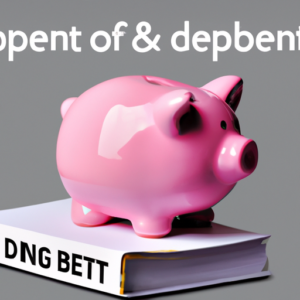In the ongoing journey towards financial stability, it is not uncommon to face the dilemma of whether to prioritize paying off debt or saving money. This article explores the complexities of this decision, analyzing various factors such as interest rates, debt types, and financial goals. By examining both sides of the coin and providing insightful tips, you will gain a comprehensive understanding of how to navigate this important financial conundrum and make the best decision for your unique circumstances.
Factors to Consider
Interest Rates
When deciding whether to prioritize paying off debt or saving money, one important factor to consider is the interest rates on your debts and potential returns on your savings. High-interest debts, such as credit cards or payday loans, can quickly accumulate expensive interest charges, making it beneficial to pay them off as soon as possible. On the other hand, if you have low-interest debts, such as a mortgage or student loans, it may be more financially savvy to focus on saving money instead, as you may be able to earn higher returns on your investments than the interest you are paying on your debts.
Financial Goals
Another factor to consider is your financial goals. Are you looking to achieve short-term goals, such as buying a new car or going on a vacation? Or are you more focused on long-term goals, such as saving for retirement or purchasing a home? Understanding your financial goals will help you determine whether it is more beneficial to prioritize paying off debt or saving money.
Emergency Fund
Having an emergency fund is crucial to provide a safety net for unexpected expenses, such as medical bills or major car repairs. If you don’t have an emergency fund, it may be wise to prioritize saving money before aggressively paying off debt. By having a financial cushion, you are better prepared to handle unexpected expenses without resorting to high-interest debt. However, if you already have an emergency fund, you can consider directing more of your resources towards debt repayment.
Debt Type
The type of debt you have also plays a significant role in determining whether to prioritize paying off debt or saving money. Some debts, like credit cards or payday loans, typically carry high-interest rates and should be prioritized for repayment due to the potential for expensive interest charges. Other debts, such as low-interest mortgages or student loans, may have more favorable interest rates and longer repayment terms, making it more reasonable to focus on saving money first.
Psychological Benefits
Lastly, it is essential to consider the psychological benefits of paying off debt versus saving money. For many individuals, the emotional burden of debt can be overwhelming and can significantly impact their overall well-being. By prioritizing debt repayment, you may experience a sense of relief and increased financial security. However, others may find comfort in having savings and being prepared for future expenses or emergencies. Evaluating the psychological impact can help guide your decision on whether to prioritize paying off debt or saving money.
Benefits of Paying Off Debt First
Reduced Interest Payments
By prioritizing debt repayment, you can significantly reduce the amount of interest you pay over time. This is especially true for high-interest debts, where even small payments can quickly add up due to compounding interest. By eliminating debt sooner, you can redirect those interest payments towards savings or other financial goals.
Improved Credit Score
Paying off debt can have a positive impact on your credit score. Your credit utilization ratio, which is the amount of credit you are using compared to your total available credit, is a significant factor in determining your credit score. By paying off debt and reducing your credit utilization ratio, you demonstrate responsible financial behavior, which can lead to an improved credit score over time.
Financial Freedom
Being debt-free provides a sense of financial freedom and flexibility. Without the burden of debt payments, you have more discretionary income to save, invest, or spend on your financial goals. Eliminating debt allows you to take control of your financial future and opens up opportunities for financial growth and prosperity.

Benefits of Saving Money First
Emergency Fund
Saving money first allows you to establish and maintain an emergency fund. This fund acts as a safety net, providing you with financial security in case of unexpected expenses or income disruptions. Having an emergency fund can help you avoid relying on high-interest debt in times of need, providing peace of mind and a solid financial foundation.
Compound Interest
When you save money, it has the potential to grow through the power of compound interest. Compound interest allows your initial savings to earn interest, and over time, the interest also earns interest. This compounding effect can significantly boost your savings and help you achieve your financial goals faster. By prioritizing savings, you can take advantage of this financial phenomenon and watch your money grow over time.
Flexible Use of Funds
Saving money first provides you with flexibility in how you use those funds. Whether it is for a down payment on a home, starting a business, or pursuing further education, having savings empowers you to seize opportunities when they arise. Additionally, having savings allows you to have more control over your financial decisions and reduces reliance on credit, providing a greater sense of financial independence.
Strategies for Prioritizing Debt and Savings
Debt Avalanche Method
The debt avalanche method involves prioritizing debt repayment based on the interest rates of your debts. Start by making the minimum payments on all your debts and then allocate any additional funds towards the debt with the highest interest rate. Once that debt is paid off, move on to the one with the next highest interest rate. This strategy helps minimize the total interest paid over time and can expedite debt repayment.
Debt Snowball Method
The debt snowball method focuses on paying off the smallest debts first, regardless of the interest rates. Begin by making minimum payments on all debts and then allocate extra funds towards the debt with the lowest balance. Once that debt is paid off, roll the amount you were paying towards that debt into the next smallest debt. This strategy provides a psychological boost as you quickly see the number of debts decrease, providing motivation to continue the debt repayment journey.
50/30/20 Budgeting Rule
The 50/30/20 budgeting rule is a simple guideline for managing your finances. It suggests allocating 50% of your income towards needs, such as housing, groceries, and transportation, 30% towards wants, such as entertainment or dining out, and 20% towards savings and debt repayment. By following this rule, you ensure that both debt repayment and savings are prioritized, allowing you to make progress in both areas.
Matching Employer Contributions
If your employer offers a retirement savings plan, such as a 401(k), it is essential to take advantage of any employer matching contributions. Employer matches are essentially free money, and by contributing enough to receive the maximum match, you can accelerate your savings while simultaneously prioritizing debt repayment.

Case Studies
Case Study 1: High-Interest Debt vs. Low-Interest Savings
In this scenario, you have outstanding credit card debt with high-interest rates, while also having low-interest savings. It would be financially savvy to prioritize paying off the high-interest debt first, as the interest charges on those debts can quickly accumulate. By focusing on debt repayment, you can save more money in the long run and then redirect those funds to savings once the debt is eliminated.
Case Study 2: Large Debt with High Income
If you have substantial debt but also a high income, it may be possible to balance both debt repayment and savings. In this case, it is advisable to allocate a significant portion of your income towards debt repayment to minimize interest charges. However, it is crucial to establish an emergency fund and save for retirement simultaneously to ensure financial stability in the long term.
Case Study 3: Moderate Debt with Limited Savings
For individuals with moderate debt and limited savings, it can be challenging to decide whether to prioritize debt repayment or savings. In this situation, it may be wise to focus on establishing an emergency fund first. Having a financial cushion can provide peace of mind and prevent taking on additional debt in case of unexpected expenses. Once the emergency fund is in place, you can shift your focus towards debt repayment while continuing to save consistently.
Balancing Debt Repayment and Savings
Establishing a Budget
Creating and following a budget is crucial when balancing debt repayment and savings. By tracking your income and expenses, you can identify areas where you can cut back and allocate more funds towards debt repayment and savings. A budget ensures that you stay on track and make progress towards both your debt repayment and savings goals.
Automating Payments
Automating debt payments and savings contributions can help you stay consistent and avoid late payments. By setting up automatic transfers and payments, you can ensure that a portion of your income goes towards debt repayment and savings without having to remember to make the payments manually. This helps maintain the momentum and discipline required to achieve your financial goals.
Seeking Professional Advice
If you are unsure about the best approach to balance debt repayment and savings, it may be beneficial to seek professional financial advice. A certified financial planner or financial advisor can evaluate your unique financial situation and provide tailored recommendations to help you make informed decisions. They can help you create a personalized plan that optimizes both debt repayment and savings based on your financial goals and priorities.

Long-Term Financial Planning
Retirement Savings
Planning for retirement is a critical aspect of long-term financial planning. Regardless of whether you choose to prioritize debt repayment or savings, it is essential to allocate funds towards retirement savings. The earlier you start saving for retirement, the more time your money has to grow through compounding interest. Utilize retirement savings accounts like 401(k)s or IRAs to take advantage of tax benefits and employer matches, if available.
Investment Opportunities
Once you have established a solid foundation of debt repayment and savings, it may be beneficial to explore investment opportunities. Investments, such as stocks, bonds, or real estate, have the potential to generate higher returns than traditional savings accounts. However, investments also come with risks, and it is crucial to conduct thorough research or seek professional advice before investing.
Lifecycle Considerations
Throughout different stages of life, financial priorities and needs change. It is essential to consider your lifecycle when making decisions about debt repayment and savings. For example, younger individuals may focus more on paying off student loans or saving for a down payment on a home, while those nearing retirement may prioritize paying off their mortgage or maximizing retirement savings. Adjust your debt repayment and savings strategy to align with your current lifecycle stage and financial objectives.
In conclusion, the decision to prioritize paying off debt or saving money depends on several factors, including interest rates, financial goals, emergency funds, debt types, and psychological benefits. While paying off debt first can lead to reduced interest payments, an improved credit score, and financial freedom, saving money first provides benefits such as establishing an emergency fund, taking advantage of compound interest, and having flexible funds for future opportunities. It is essential to consider strategies like the debt avalanche or snowball methods, as well as budgeting rules, employer contributions, and seek professional advice if needed. Additionally, balancing debt repayment and savings involves establishing a budget, automating payments, and considering long-term financial planning for retirement savings, investment opportunities, and lifecycle considerations. By carefully evaluating these factors and weighing the benefits, you can make an informed decision that aligns with your financial goals and priorities.

